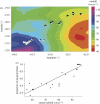Why are not all chilies hot? A trade-off limits pungency
- PMID: 22189403
- PMCID: PMC3311884
- DOI: 10.1098/rspb.2011.2091
Why are not all chilies hot? A trade-off limits pungency
Abstract
Evolutionary biologists increasingly recognize that evolution can be constrained by trade-offs, yet our understanding of how and when such constraints are manifested and whether they restrict adaptive divergence in populations remains limited. Here, we show that spatial heterogeneity in moisture maintains a polymorphism for pungency (heat) among natural populations of wild chilies (Capsicum chacoense) because traits influencing water-use efficiency are functionally integrated with traits controlling pungency (the production of capsaicinoids). Pungent and non-pungent chilies occur along a cline in moisture that spans their native range in Bolivia, and the proportion of pungent plants in populations increases with greater moisture availability. In high moisture environments, pungency is beneficial because capsaicinoids protect the fruit from pathogenic fungi, and is not costly because pungent and non-pungent chilies grown in well-watered conditions produce equal numbers of seeds. In low moisture environments, pungency is less beneficial as the risk of fungal infection is lower, and carries a significant cost because, under drought stress, seed production in pungent chilies is reduced by 50 per cent relative to non-pungent plants grown in identical conditions. This large difference in seed production under water-stressed (WS) conditions explains the existence of populations dominated by non-pungent plants, and appears to result from a genetic correlation between pungency and stomatal density: non-pungent plants, segregating from intra-population crosses, exhibit significantly lower stomatal density (p = 0.003), thereby reducing gas exchange under WS conditions. These results demonstrate the importance of trait integration in constraining adaptive divergence among populations.
Figures



Similar articles
-
Costs and benefits of capsaicin-mediated control of gut retention in dispersers of wild chilies.Ecology. 2008 Jan;89(1):107-17. doi: 10.1890/07-0445.1. Ecology. 2008. PMID: 18376552
-
Evolutionary ecology of pungency in wild chilies.Proc Natl Acad Sci U S A. 2008 Aug 19;105(33):11808-11. doi: 10.1073/pnas.0802691105. Epub 2008 Aug 11. Proc Natl Acad Sci U S A. 2008. PMID: 18695236 Free PMC article.
-
Where did the chili get its spice? Biogeography of capsaicinoid production in ancestral wild chili species.J Chem Ecol. 2006 Mar;32(3):547-64. doi: 10.1007/s10886-005-9017-4. Epub 2006 Mar 30. J Chem Ecol. 2006. PMID: 16572297
-
Factors affecting the capsaicinoid profile of hot peppers and biological activity of their non-pungent analogs (Capsinoids) present in sweet peppers.Crit Rev Food Sci Nutr. 2021;61(4):649-665. doi: 10.1080/10408398.2020.1743642. Epub 2020 Mar 26. Crit Rev Food Sci Nutr. 2021. PMID: 32212928 Review.
-
Capsaicinoids: Pungency beyond Capsicum.Trends Plant Sci. 2019 Feb;24(2):109-120. doi: 10.1016/j.tplants.2018.11.001. Epub 2019 Jan 7. Trends Plant Sci. 2019. PMID: 30630668 Review.
Cited by
-
Fungal Seed Pathogens of Wild Chili Peppers Possess Multiple Mechanisms To Tolerate Capsaicinoids.Appl Environ Microbiol. 2020 Jan 21;86(3):e01697-19. doi: 10.1128/AEM.01697-19. Print 2020 Jan 21. Appl Environ Microbiol. 2020. PMID: 31732572 Free PMC article.
-
The Influence of Different Factors on the Metabolism of Capsaicinoids in Pepper (Capsicum annuum L.).Plants (Basel). 2024 Oct 15;13(20):2887. doi: 10.3390/plants13202887. Plants (Basel). 2024. PMID: 39458834 Free PMC article. Review.
-
Biochemistry and molecular biology of capsaicinoid biosynthesis: recent advances and perspectives.Plant Cell Rep. 2019 Sep;38(9):1017-1030. doi: 10.1007/s00299-019-02406-0. Epub 2019 Apr 2. Plant Cell Rep. 2019. PMID: 30941502 Review.
-
Searching for the bull's eye: agents and targets of selection vary among geographically disparate cyanogenesis clines in white clover (Trifolium repens L.).Heredity (Edinb). 2013 Dec;111(6):495-504. doi: 10.1038/hdy.2013.71. Epub 2013 Jul 31. Heredity (Edinb). 2013. PMID: 23900395 Free PMC article.
-
Integrating TRPV1 Receptor Function with Capsaicin Psychophysics.Adv Pharmacol Sci. 2016;2016:1512457. doi: 10.1155/2016/1512457. Epub 2016 Jan 14. Adv Pharmacol Sci. 2016. PMID: 26884754 Free PMC article. Review.
References
-
- Ghalambor C. K., Reznick D. N., Walker J. A. 2004. Constraints on adaptive evolution: the functional trade-off between reproduction and fast-start swimming performance in the Trinidadian guppy (Poecilia reticulata). Am. Nat. 164, 38–5010.1086/421412 (doi:10.1086/421412) - DOI - DOI - PubMed
-
- Conner J. K. 2002. Genetic mechanisms of floral trait correlations in a natural population. Nature 420, 407–41010.1038/nature01105 (doi:10.1038/nature01105) - DOI - DOI - PubMed
-
- Via S., Hawthorne D. J. 2005. Back to the future: genetic correlations, adaptation and speciation. Genetica 123, 147–15610.1007/s10709-004-2731-y (doi:10.1007/s10709-004-2731-y) - DOI - DOI - PubMed
-
- Schluter D. 2009. Evidence for ecological speciation and its alternative. Science 323, 737–74110.1126/science.1160006 (doi:10.1126/science.1160006) - DOI - DOI - PubMed
-
- Miller S. P., Lunzer M., Dean A. M. 2006. Direct demonstration of an adaptive constraint. Science 314, 458–46110.1126/science.1133479 (doi:10.1126/science.1133479) - DOI - DOI - PubMed
Publication types
MeSH terms
Substances
LinkOut - more resources
Full Text Sources

